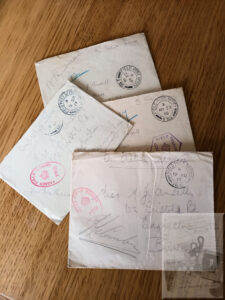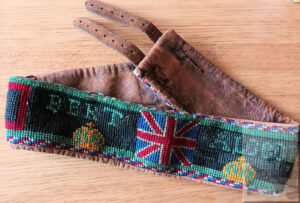WW1 Envelopes and a Hand-crafted Belt
A cardboard box full of WW1 ephemera was given to me recently and packed full of beautiful bits and bobs. What is inside the container? A trench periscope, envelopes, a 1918 New Year card, a snuff box in the style of Dutch clog, a tapestry belt, and much more. One of the utmost special items was an original newspaper from the 11th of November 1918.

A set of four letters sent from a soldier on Active Service ©
Firstly, I would like to tell you about the envelopes. All of them had been addressed to Miss M J Ansell, Ben More, 62 Bristol Road, Edgbaston, Birmingham.
Who is or was Miss M J Ansell?
You must know a little of me now to see that I am a sucker for a name, a serial number or any clue that may lead me to someone no longer walking among us and able to tell their tale.
So many questions arose from the envelopes – when was she born, who were her parents, did she have an occupation, did she marry and have a family? To my great sadness, the letters were no longer in their original packaging. So many bits were needed to complete my jigsaw. As a result, with no letters, this was a one-sided chase!
The letters were dated the 23rd of April and 23rd of May 1916 and the 19th of August and 29th of September 1917. Each discoloured envelope was postmarked from a Field Post Office and passed Field Censorship. Should I rightly or wrongly assume the writer had been a soldier, not a VAD or a nurse who had been in one theatre of war and then moved as the censor office numbers changed from 937 to 799?
Let’s get started by using ANSELL in Edgbaston on the online website. The results came back; one stood out in the 1911 census. Mabel Jessie Ansell a 29-year-old Secondary School Teacher. Mabel was the daughter of William, a 62-year-old manufacturer of iron and brass ship fittings and Jessie Ewen Smith, aged 63 at the time living at 78 Bristol Road, Edgbaston.
By 1921 Mabel’s father and Jessie’s husband had died (1919), and the family home was now a little down the road at 62 Bristol Road. Jessie, on the completed census form, says she is the mistress of the house. Mabel was now a science teacher at King Edward Grammar School, Camps Hill. The census form also included 16-year-old Millicent Stackhouse, the family servant.
Going back to William, he had died in Bushwood Nursing Homes, St Jame’s Road, Edgbaston, just a 15 minutes walk away from the family home. Did William leave any money? Yes, he did! He left £29,664 5s 5d to his widow, Jessie and his children, Mabel and Frank and Oliver Richard White, Chartered Accountant, was left to deal with his accounts.
Jessie died in 1935. According to Probate Register, she left just over £7,000 – where had the money gone? The money was left to Mabel, Frank Ewen Ansell, and Herbert William Lyde.
Mabel’s brother Frank (d 1956) had married Ethel Lomax in the Kings North Registration District in 1910. The couple had Ewan P Ansell, born in 1913, followed by Peter Benson Ansell, born in 1916. Ewen married Elizabeth Woodward in 1943. Ewan died in 1973, but in his career as a pulley manufacturer, he took out a Patent in 1959 based on improvements of a pulley design and mounting.
Peter Benson Ansell went to the same school where his aunt taught – did he get preferential treatment? At school, Peter was a star on the rugby and cricket fields. His rugby position was centre three-quarter. He also played for the Edwardians. When at Birmingham University, studying Medicine, he was also part of their Rugby team. On three occasions, he played for the North Midlands Union. He was also a keen supporter of Midland Rugby Club. Sport was undoubtedly in the family, as his grandfather, William, was for many years the honorary secretary of Warwickshire Cricket Club. When the 1939 Register was taken, Peter was a medical student at the General Hospital along with many other students, doctors, surgeons, nurses, and of course, patients.
Peter died on the 17th of October 1940 while still a medical student because of an accident. With Peter’s death being during WW2 and his age making him eligible for war service, the CWGC website was searched next, and here I got a surprise. Peter’s death was not military but civilian.
Peter is remembered on the Birmingham University Roll of Honour, his local church in Streetley, Birmingham but sadly is NOT on his school memorial. He may not have fought, but he died due to enemy action. German fighter bombers were attacking London, Liverpool and Birmingham on the night of his death. The visibility was terrible that night, making detecting enemy action very difficult. Even so, Birmingham was not left in peace, and over 2,000 souls lost their lives during WW2. I remember I read that he was injured while driving and then taken to the Queen Elizabeth Hospital, where he sadly died. I seem to have misplaced this source, though.
Mabel, I’m still working on her! In 1939, she lived at 113 West Street, Warwick and still worked in her chosen profession, teaching.
Mabel died on the 22nd of July 1963 in Birmingham and left £4,988 19s for Lloyds Bank to distribute according to her will.
Mabel remained a spinster all her life, and this raises more questions. Why is it with family history, be it your own, for someone else or just a name that sounds interesting there, is always another question? Mabel never married. Could the four envelopes contain letters written by her beau? Is it even more possible that she remained single because he never came home? Only Mabel knows. Or does she? Can someone else answer my question?

WW1 belt made by Bert Alcock ©
Secondly, I’d like to tell you about the tapestry belt. That is the only way I can describe it. Hand stitched on a repurposed leather back and leather straps. Worked into the belt are A Alcock and the year 1916. Who was A Alcock?
Using the CWGC as a base source, there were quite a few soldiers who could have been the owner of the belt. Saying that I am presuming, a thing you should not always do, that he died during the war. He could have survived. The previous belt owner had done a little research and thought he was Albert Harry Alcock. Whether right or wrong, this is all about Albert and the few bits of information I was given and a great deal more found by myself.
Albert Harry was one of three sons (Fred and John William) of John and Wilhelmena nee Willisford, who had married in St Mary’s Uttoxeter in 1887. All three of their sons went to war, a war that was later to be known as The Great War.
Back at the time of the 1911 census, only Fred and Albert, known as Harry, lived in the family home. The three brothers all enlisted into the army sometime after hostilities began. Fred joined the 1/6th North Staffordshire Regiment and became Private 2635. William became Private 18553 in the York and Lancaster Regiment. Albert Harry became a Private in the 1/6th North Staffordshire Regiment, the same regiment as his brother.
All three brothers paid the ultimate sacrifice.
Fred died on the 2nd of July 1915 and rests in Blauwepoort Farm Cemetery, Belgium. He was only 19 years old.
The military Pension Records belong to the Western Front Association and can be accessed via the WFA website (members) or Fold3. These records tell that William John had been classed as missing after the first day of the Battle of the Somme, 1 July 1916. He was later classified as dying on that day. He is remembered on the Thiepval Memorial to the Missing. He was 25 years old. William’s Pension Card, like many others, includes the names and ages of his siblings – and sometimes their regiments. The brothers’ father was next of kin, and a change of address had been included.
Using Pension Cards, Albert Harry was also classified as missing on the 1st of July 1916, like his brother is remembered on the Thiepval Memorial to the Missing.
In just twelve months, John and Wilhelmina had lost three children, two on the same day, and received less than £28 from the Government in return.
Wilhelmena died in Cheadle in 1942. John lived a few more years and died in 1953.
If only A Alcock could confirm he was the soldier?
 James was a Solicitor and Town Clerk of the Borough of Wakefield who died on the 22nd of April 1867, according to his headstone. The headstone is three rather solid squares of stone set on a solid base with a splendid four-cornered spire. It looks quite impressive as most of the headstones around are of a more standard size and shape.
James was a Solicitor and Town Clerk of the Borough of Wakefield who died on the 22nd of April 1867, according to his headstone. The headstone is three rather solid squares of stone set on a solid base with a splendid four-cornered spire. It looks quite impressive as most of the headstones around are of a more standard size and shape.